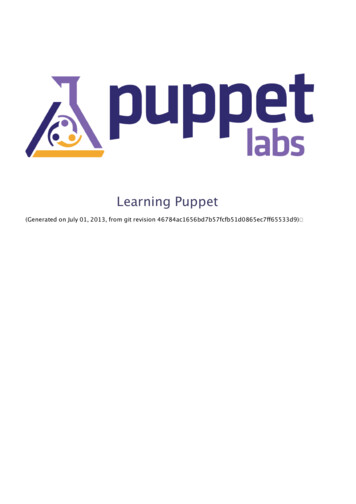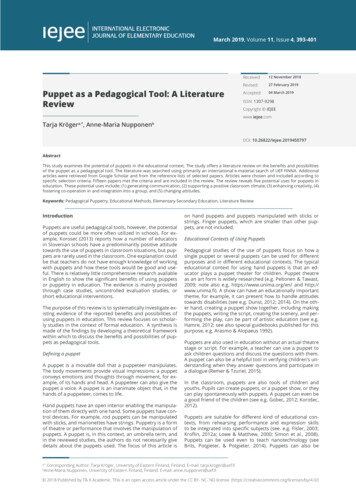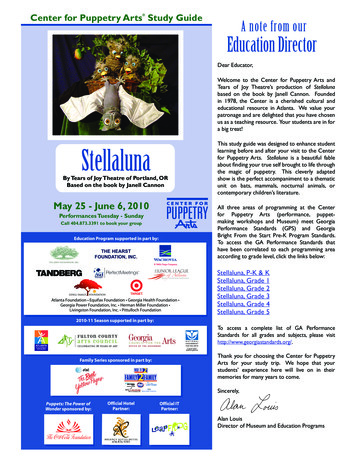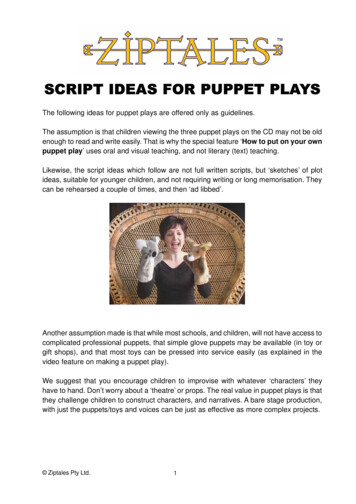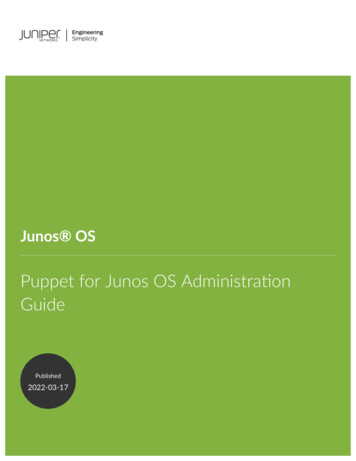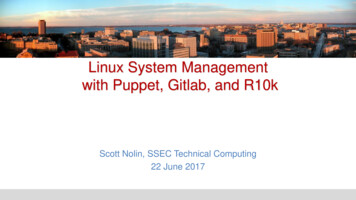
Transcription
Linux System Managementwith Puppet, Gitlab, and R10kScott Nolin, SSEC Technical Computing22 June 2017
IntroductionI am here to talk about how we do Linux configuration management at the Space Scienceand Engineering Center.I am doing this to encourage others doing similar work so we can ideally share ideas andlearn from each other.
Why We need Linux configuration managementSSEC’s mission and structure requires many hundreds of systems, and many groups withdifferent needs running systems. Linux systems are the core of our research systems. Ensure consistency and repeatability Faster time from install to production Adapt to change quickly Lower labor costs Computer Security Applying computer policy consistentlyAuditing
Why Version Control Version control of configurations reduces fear and increases accountability. See Dave Plonka’s ‘Sysadmin File Revision Control with RCS’ from 1998 Modern system administration favors more frequent small changes, and version control makes thiseasy. We had done this for many years with CVS, SVN, and now git for some of our configurations. DNS zone files Monitoring server configuration (check mk/omd) Version control was the end of the process – after changing a configuration it got stored in versioncontrol. With Puppet, you manage ‘everything’, so configuration management is even more important. We moved version control to the forefront. We now start with version control and end with changesin puppet. Version control is how we trigger a configuration change, not how we store a change we made.
SSEC System Components Puppet – configuration management serverGitlab– git server, with integrated Continuous Integration features (CI). Foreman – Puppet GUI and node classifier Includes gitlab-ciCI Scripts you write do the work: bash, perl, python, whatever you wantoptional, but niceR10K Code management tool that maps Git branches to Puppet environments.Make a branch called ‘testing’ in git, and an puppet environment called ‘testing’ is created.Assign test machines to testing branch and test.
Puppet History at SSEC2011, Initial: Puppet server for testing and light use Used to distribute science software rpms/lmod modules, yum repositories, and monitoring client checksEdit modules directly on serverAssign modules to hosts in puppet server configuration filesNo integrated version control (ad-hoc for some modules)February 2015, Configuration as Code: Puppet, Gitlab, gitlab hooks, and puppet-sync Version Controlled pdxcat/puppet-sync Pre-receive hooks for tests, Post-receive hooks for puppet-sync branches are environments Git workflow accelerated development of modules Used for ‘everything’, new stuff and converting existing. Problem with git client and gitlab gui and hooks - tests were in pre-receive, never get triggered in GUI Monolithic gitlab repository bad for sharing with other groupsJuly 2016, Gitlab-CI method: Puppet, Gitlab, Gitlab-CI, and R10k The gitlab GUI is a first class citizen CI/CD methods are generally well understood and accepted Gitlab-CI provides a GUI, making it easier to visualize and maintain your production pipeline.June 2017, Upgrade to Puppet 4
Foreman Foreman provides a GUI for Puppet, system provisioning and more. Foreman also provides the Puppet Server install To make new classes or environments available in Foreman, we import them via theGUI manually after our Gitlab/r10k/puppet workflow completes.You will see “Foreman Import” in the CI steps, but this is just a placeholder in case wedecide to automate further.
SSEC Workflow: Routine Administration Node Classification – we use Foreman as External Node Classifier Assign nodes to environments, such as a test environmentAssign modules (puppet classes) to groups of nodes or individual nodesRoutine changes can be done in master branch of control repository. We can use theGitlab GUI or git cli. User operations: add local users, override attributes (example: modify UID if needed), Allowaccess to a machine for a domain user.Manage public keysSudoersAdd Applications
SSEC Workflow: Bigger Changes1. Create short lived branches, for example “scott test”2. Assign test nodes to scott test environment3. Test changes4. Merge test branches to master5. Move test nodes back to master
Configuration FreezeWe typically use the system to enact change. We can also use the system to avoidchanges. We did this for a group of critical systems for a week during GOES-16deployment. Made a branch called ‘goes freeze’, put hosts in that environment Pinned every puppet module to a specific commit Disabled automatic yum updates in our yum module When the freeze period was over, moved the hosts to the normal environment. Theythen got all the changes that happened in that time period.In the past this may have caused us to simply pause some of our work, now it does not.
Long Lived Branch WorkflowOur short lived branch workflow is only one way to do this. Another idea is to have a longlived test branch. Force all changes to go to the test branch and merge to master (or ‘production’) afterpassing Have some hosts permanently assigned to the test environment This can be a highly structured workflow with checks and balances. Only some adminscould be allowed rights to merge for example. These methods can be combined. Permanent testing VM’s for a long lived branch, butstill doing the short-lived branch test methods is a direction we may go at SSEC. Iespecially like the idea of some nightly complete system rebuild testing.
Where did I get the idea for puppet/r10k/gitlab?This is based on first looking at Phil Zimmerman’s‘An Automated R10K Workflow That Works’ and attempting to replicate -workflow-that-works/This uses R10kGithub ub.com/pzim/reaktorAs I was wrestling with various components gitlab-ci developed rapidly and showed great promise.It worked.
R10K: Control Repository and PuppetfileThe control (git) repository controls the puppet environments, it is a critical component. The controlrepository contains the Puppetfile and more.The puppetfile is a file listing all other repositories with modules you use. These can be anycombination of your own git or puppet forge, your own private, or someone else’s. For security we use adedicated gitlab server, and download, curate and re-host any repositories we use from outside.Consider that you likely would not share your control repository with others, but may share othermodules, which are building blocks.#Puppetfile example#Here are some Puppet Modules. These reference our git server, but#could be any git or puppet forgemod 'ipmi',:git 'git@sgit.ssec.wisc.edu:tc-puppet/ipmi.git',:ref 'master'mod 'winbind',:git f 'master'mod 'augeasproviders core',:git 'git@sgit.ssec.wisc.edu:tc-puppet/augeasproviders core.git',:ref 'master'mod 'zpool scrub',:git 'git@sgit.ssec.wisc.edu:tc-puppet/zpool scrub.git',:ref 'master'
R10K: Control Repository ContentsAnything that is routinely changed is more convenient in control than an externalrepository. You could have a mostly empty puppetfile and put most puppet modules incontrol, mimicking our monolithic puppet-sync method. hieradata – this can be it’s own module, but for SSEC, is changed frequently. Forexample, it’s how we allow users login to linux systems. I believe hieradata in control isfairly common. site/ modulename – we put the ‘site’ directory is in the modulepath, so this addsmodules in the control repo directly You can put any modules you want in site/We use - site/profiles, site/role, and site/hostgroups. Notice these are generally ‘sitespecific’ things for SSEC, likely would not be shared. They’re how we compose things,using other basic building block modules from outside control repo, as defined in thePuppetfile.
Gitlab CIGitlab CI is an integrated CI/CD system that comes with gitlab for testing, building, anddeploying code Continuous Integration (CI) is a development practice where you integrate code for aproject frequently. Check-ins are tested via an automatic build process. Continuous Deployment (CD) is similar, focused on delivery of software to the end user.In our use case, we test our puppet modules, and deploy them to the puppet server. Weuse Gitlab-CI and R10K instead of our previous git server-side hooks and pdxcat/puppetsync.
Push to GitlabProcess FlowIs code valid(passes tests)?NoYes (Control Repo)Is this controlrepository?No (Is Module)Is code valid(passes tests)?YesYesHas PuppetfileChanged?Does controlhave a matchingbranch?NoYesYesR10K deployenvironment and allmodulesNoGet controlrepo andPuppetfileR10K deployenvironment onlyYesIs module inPuppetfile?YesReport ErrorReport ErrorR10K deploy moduleEnd
Data FlowCodeGitlab ServerPuppet ServerPuppetModuleGit RepoGitlab CIGitlab CIConfigurationR10KPuppetControlGit RepoGitlab Runner ServerTestDeployPuppet configfiles
Authentication Between Components Gitlab deploy keys – allow read-only access to a gitlab repository R10K user @ puppet server’s ssh public key is used as gitlab deploy key on control andmodule repos. This is how r10k@puppet server grabs the repositories from gitlab. Gitlab-runner user @ runner server’s ssh public key is used as gitlab deploy key on the controlrepository only. The runner uses this to get the puppetfile for tests. Normal system SSH keys Gitlab-runner@runner server ssh public key is added to r10k@puppet server authorizedkeys. This is how the gitlab runner can ssh to the puppet server to run r10k commands. We manage public keys with puppet, adding them to authorized keys. Of course there’s thebootstrap issue for these in particular.
AuthenticationCodeGitlab ServerPuppet ServerPuppetModuleGit RepoGitlab CIGitlab CIPuppetControlGit RepoConfigurationControl and all module reposGitlab deploy key R10k@puppetserver pubkeyR10KPuppet configfilesControl repo Gitlab deploy key gitlab-runner@runner server pubkeyGitlab Runner ServerTestGitlab-ci process handles authDeploygitlab-runner@runner server pubkeyin r10k authorized keys
Gitlab CI: Control RepositoryAdding .gitlab-ci.yml file to the repo defines the processstages:- test- r10kpuppet test:stage: testscript: puppet testallow failure: falsehiera test:stage: testscript: hiera testallow failure: falser10kdeploy:stage: r10kscript: r10k control deployallow failure: falseScripts are run on the gitlab-runner linux host.There are docker and shell runner methods, weuse shell, but either will work.The gitlab-runner user simply executes whateverscript you give it in it’s shell.This naturally has security concerns, the gitlabrunner needs to be treated as securely as allother system components. If compromised, allyour hosts are compromised easily.
Clicking the CI Step shows the output.In this case I modified r10k control deploy itself.I found a bug while making these slides.
What happened? Gitlab-ci ssh’ed to the puppet server andran r10k deploy.print "DEPLOY ENVIRONMENT ONLY:\n";system ("ssh r10k\@ {PUPPETSERVER} r10k deploy environment r10k env --verbose");
Clicking the commit shows the diff
Gitlab CI: All Other ModulesThe .gitlab-ci.yml file for modules is slightly differentstages:- test- r10kdeploypuppet test:stage: testscript: puppet testallow failure: falser10K modtest:stage: testscript: r10k modtestallow failure: falser10k moddeploy:stage: r10kdeployscript: r10k moddeployallow failure: falseOur general puppet tests are the same, andnotice we don’t test hieradata – that lives incontrol only.We do module specific tests and deployment.
Gitlab CI Script DetailsGitlab-CI scripts are the glue that make the process work.I designed the test scripts to also work as pre-commit scripts This avoids running pipelines that will fail tests and speeds up workflow Pre-commit scripts only work at the git cliExample Scripts are here: https://gitlab.ssec.wisc.edu/scottn/pgr10k We are still changing these periodically, and Gitlab is in active development, so will notinclude the in these slides.
Discussion
SSEC System Components Puppet –configuration management server Gitlab–git server, with integrated Continuous Integration features (CI). Includes gitlab-ci CI Scripts you write do the work: bash, perl, python, whatever you want Foreman –Puppet GUI and node classifier optional, but nice R10K Code management
